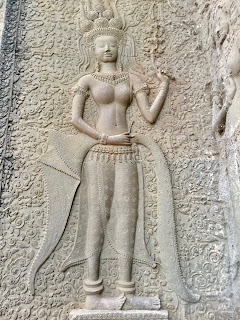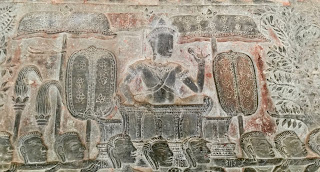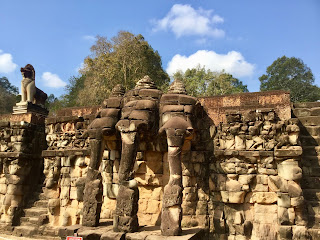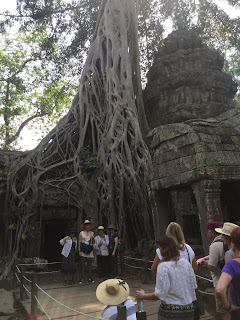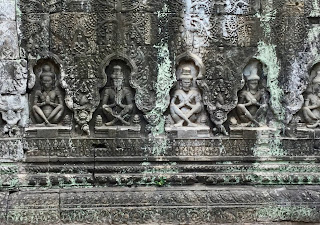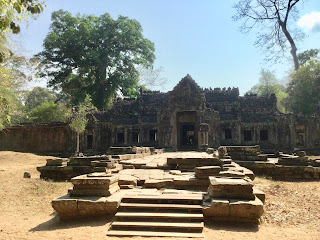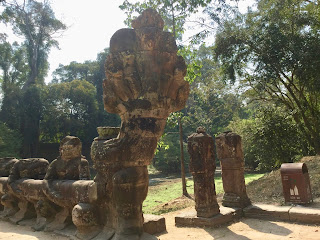Hello!
For some unknown reason my post on Angkor Wat was published yesterday before it was ready. If you had it delivered to your email last night, please check the website...kmentink.blogspot.com to see if you received the completed version.
Thanks to all my loyal followers. You are few and far between so I appreciate your interest more than I can say.
Kathy
Welcome to my blog! I plan to use this forum to keep my family and friends informed about our travels around the world. Starting in 2018, my husband, Lance, and I will be on the road full time with no home base. Please check in from time to time to see where we are and what we are learning about this wonderful world.
Tuesday, February 26, 2019
Monday, February 25, 2019
Angkor Wat - The Eighth Wonder of the World
One of the main reasons we decided to visit Cambodia was to see the world famous Angkor Wat temple. This temple is a national treasure that is featured on the country flag, and is the pride of the Cambodian people. It has been in continuous use since it was built, and unlike some of the other temples, it has never been abandoned to the elements of the jungle.
Angkor Wat was built by Khmer King Suryavarman II early in the 12th century. He built the temple to honor the Hindu God, Vishnu. It is also believed that the king intended to use Angkor Wat for his mausoleum, however he was never buried inside it. It only took about 37 years to complete the construction of the temple, which is truly remarkable. Creating it involved approximately 300,000 workers, which included architects, construction workers, masons, sculptors and servants who were used to feed the workers. Six thousand elephants also assisted with the construction of the site. Five to ten million sandstone blocks used to build the structures were quarried 25 miles or more away and floated down canals on rafts. The maximum weight of each block would have been roughly 1.5 tons. The buildings and towers were constructed using no mortar between the blocks.
Eleanor Mannikka, explains in her book, Angkor Wat: Time, Space and Kingship, that the temple was built like other temple mountains, to replicate the spatial universe in miniature. The central tower is Mt. Meru, with the shorter towers representing the surrounding peaks...the lower courtyards represent the continents...and the moat represents the oceans. Although Angkor Wat was first built as a Hindu temple, it later became a Buddhist temple, and remains one today.
 |
| Vasuki, one of the King serpents of Hindu and Buddhist religions, guards the entrance to the bridge entrance to Angkor Wat. |
 |
| One of three entrances to the temple. |
 |
| The eight armed statue of Vishnu/Buddha stands in a small room on the outer wall of Angkor Wat. |
Below is a picture of an Apsaras...a heavenly nymph. There are more than 2,000 nymphs carved into the walls of Angkor Wat. Each one is unique with different patterns on their clothes, or different poses, jewelry, hair styles or hair ornaments. They are a delight to look at.
 |
| The peaks you see on the towers are the heads of serpents. |
 |
| One of eight pools found inside the structure. There are four pools on the first level of the temple and four more pools inside the middle tower. |
 |
| Views looking down from inside the middle tower. |
 |
| Sculptures can be found throughout the temple on nearly every surface of the buildings. |
 |
| Tourist friendly stairs leading up and down from the middle tower. |
 |
| One of several libraries found on the grounds. |
Below are several photos of bas-relief scenes found on serveral of the walls of Angkor Wat.
 |
| Photos above and below...A sinner being driven full of nails in a depiction of hell. This is a part of the san-relief scenes depicting Heaven and Hell. |
 |
| Monkeys can be spotted on the roof of the temple and the surrounding areas. |
 |
| Lance and I with our tour guide for the day...Chann Dok Dara Veachear. He also teaches school. |
The Temples of Cambodia
Angkor Thom ( The Great City,) and Bayon Temple
Angkor Thom is considered the last great capital of the Khmer empire. Bayon, the state temple located within the city, at one time had 54 Gothic towers that were decorated with 216 giant smiling faces of Avalokiteshvara. Avalokiteshvara is an enlightened being who embodies the compassion of all Buddhas. During the past centuries some of these towers have crumbled, but the ones that remain have faces that seem to look down from every angle inside the temple, showing power and control...and a little humanity. The Bayon temple demonstrates the change in the Khmer empire from Hinduism to Buddhism.
Along with the giant heads, you can find famous carvings located on the outer wall on the first level of the temple. These bas-reliefs (sculptures in which shapes are carved so that they are only slightly higher than the flat background,) show vivid scenes of everyday life in 12th century Cambodia. It was one of the most fascinating things for me to see during our visit to the temples.
Along with the giant heads, you can find famous carvings located on the outer wall on the first level of the temple. These bas-reliefs (sculptures in which shapes are carved so that they are only slightly higher than the flat background,) show vivid scenes of everyday life in 12th century Cambodia. It was one of the most fascinating things for me to see during our visit to the temples.
 |
| One of several roads leading to Bayon Temple. |
 |
| The gate to enter Bayon Temple |
A few examples of the many bas-reliefs found on the outer wall located on the first level of the temple.
The gothic towers and smiling faces of Avalokiteshvara.
After departing Bayon temple we hiked past two other buildings...one which had archaeologists busy excavating part of the site.
As we worked our way toward the parking lot, we saw the Terrace of the Elephants. This was a platform used by one of the Khmer kings to view his army. Our guide told us that it was also used by the king to view elephant fights.
 |
| Vesna, our official guide for the day that shared some of the history about what we were seeing. He traveled with us throughout the day. |
Next, it time to meet up with our Tuk Tuk driver, Borai, and travel to Ta Prohm.
Ta Prohm
Ta Prohm is a Mahayana Buddhist monastery and university built during the late 12th and early 13th centuries. After the fall of the Khmer Empire in the 15th century, it was abandoned and neglected for centuries. Today most of it is still in the same condition that it was found in the early 21st century, with trees growing out of the ruins and the jungle attempting to swallow it up.
An Angkor scholar, Maurice Glaize, said the decision was made to not restore the temple, but to leave it as it was found because "it was one of the most imposing (temples) and the one which had best merged with the jungle, but not yet to the point of becoming a part of it." However, in recent years, much work has been done to stabilize the ruins, and permit safe access to the site. In my opinion, it is one of the most interesting temples to visit...and one of my personal favorites.
Ta Nei Temple and Preah Khan Temple
After a day of rest, we resumed our exploration and paid an early morning visit to Ta Nei temple. This is a small, unrestored temple inside a forest. Gibbon monkeys are also known to be found in this area...but we did not spot any during our visit. This temple was Lance's personal favorite because there were no other tourists there during our brief visit.
 |
| The worker that can be spotted in the background is busy sweeping leaves. A great effort is made to keep all the temples free of debris. |
Next we traveled to Preah Khan temple. It is much larger than Ta Nei...and seems to have had some restoration work done on many of the buildings.
Below is a picture of Borai. He was our favorite Tuk Tuk driver, and for $20.00 we got to have him for the entire day. Borai is a kind and gentle soul...soft spoken and a delight to be around. He taught himself English by watching You Tube. At the end of our second day of temple exploration we treated him to lunch.
Subscribe to:
Posts (Atom)
